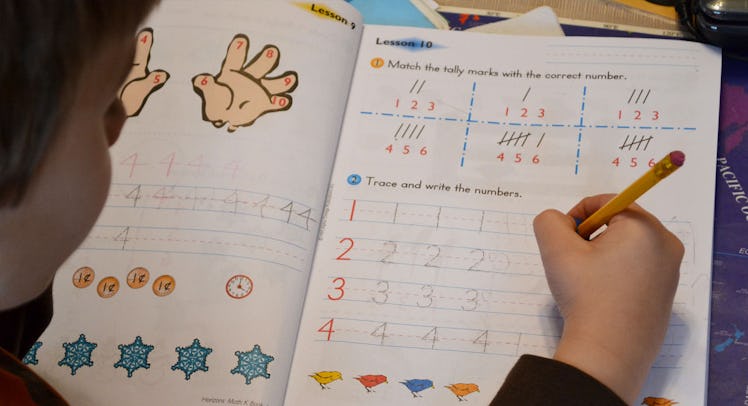How to Teach Your Kids to Love Math in 6 Easy Steps
It's a simple equation.

Kids are afraid of lots of things: Monsters, shots, Santa, fire alarms, guys with beards. But one of the biggest fears they’re likely to develop as an adult is arithmophobia. That’s the fear of math. You might still have anxiety over equations, but your kids don’t … yet. That’s because toddlers naturally do math in their tiny noggins. “One of most surprising things you find when you work with 2- or 3-year-old kids is how soon you realize they’re excited about math. It is not a foreign subject to them,” says Azadeh Jamalian, Ph.D., co-founder and Chief Learning Officer of learning software company Tiggly. Even if they can’t articulate it, kids perform basic addition and even division when playing with blocks or toys in various units. Kids see math as a natural form of play, full of potential humor and fun.
RELATED: The Best Math Apps For Kids That Teach Arithmetic And Geometry
Jamalian says the reason many kids end up hating math is because a) schools suck the fun out of it, and b) you tend to transfer your own math anxiety on like a hereditary trait. Except instead of thinning hair, it’s crippling fractions. She says there’s a simple way to solve this problem, and it has nothing to do with solving for x.
Stay Cool — They Can Sense Fear
When you’re busting out your best bedtime story characters, your kid can sense how stoked you are to read with them. Conversely, they can also tell when you’re just going through the motions. Same deal when you’re helping with homework. “Parents who think of themselves as not good at math, when they try to help with math homework, they transfer that anxiety,” says Jamalian. So relax and be a model mathematician. And when the concept of subtraction isn’t clicking, you can use gummy bears to show them what happens when you have 5 and 3 jump into your mouth.
Math Isn’t A Chore, Chores Are
Lots of adults — including many school teachers — think math is boring. “Kids are actually born to think in math terms, and as adults we need to be conscious about that ability, not just think that math is boring and that we need to make it fun,” says Jamalian. “Fun” is code for rewarding them with treats or turning the lesson plan into carnival of delights. She says while those intentions are good, the outcome is bad. This “chocolate-covered broccoli” approach sends the message math is something you deal with to get to something worthwhile. Tell them to save that attitude for activities that deserve it. Like cleaning the house. Or jogging.
Connect Math to Real-Life Situations
“Make sure you connect math language to the experiences they have in the world,” says Jamalian. That means, whenever possible, math should be woven into what you’re doing with your kids. The kitchen is a perfect place. Look, these spoons have fractions on them. Use phrases like, “Let’s add this…” or “Let’s count these…” to connect addition and subtraction symbols they learn in school with making their dinner. And, your kid might not know how to compare “apples to oranges” yet, but by the time they hit 2 they should be able to count them.
By starting their math class before they actually find themselves in a math class, you’re also giving them a leg up “Young children who don’t have these exposures at home reach math learning milestones later, and that hurts them when they start being introduced to formal math,” Jamalian says. A Few Other Quick Ways To Do ‘Real World’ Math
- Count steps. Whenever you take the stairs, have them leap up 2 or 3 at a time to get them counting in 2s and 3s. Fitbit, you’re fired.
- Play Monopoly. Nothing trains kids to count like cold, hard, neon cash. If they can’t tell whether they have enough to put hotels or houses on Park Place, they can’t win. And if you’ve noticed, kids hate to lose.
- Steal from current events. The Chicago Cubs gave all young baseball fans a chance to do some quick math in their head. If it took 108 years to win the 2016 World Series, what year will it be in another 108?
This article was originally published on